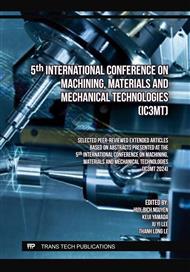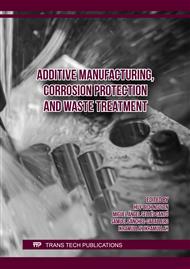[1]
H Iwabe, Y Fujii, K Saito, T Kishinami, Study on Corner Cut by End Mill, Japan Society of Precision Engineering, 5-55(1989) 841-846
DOI: 10.2493/jjspe.55.841
Google Scholar
[2]
Wang, Y., et al. "High-Speed Milling of Titanium Alloys: A Review." International Journal of Machine Tools and Manufacture, vol. 110 (2016) 27-39.
Google Scholar
[3]
Smith, S., et al. "Dynamic Analysis of High-Speed Milling Operations." CIRP Annals, vol. 64, no. 1(2015) 71-74.
Google Scholar
[4]
H Iwabe, Y Fujii, Study on Corner Cut by End Mill (2nd Report), Japan Society of Precision Engineering, Vol57, No11, 1991, pp.1995-2000.
Google Scholar
[5]
Liu, Z., et al. "Optimization of Tool Path in Machining Complex Geometries." Precision Engineering, vol. 53 (2018) 182-190.
Google Scholar
[6]
Yuri Petrakov, Olexander Ohrimenko, Maksyu Gladskyi Forecasting the cutting force in end milling, Engineering technological systems, 3-1(129), (2024), pp.80-87
DOI: 10.15587/1729-4061.2024.303791
Google Scholar
[7]
F Nakano, K Yanagihara, Basic Study on Magnetic-Field Assisted Cutting, production research, Institute of Industrial Science (IIS) the University of Tokyo.9-52(2000).
Google Scholar
[8]
Firas A. Khasawneh, Oleg A. Bobrenkov, Investigation of Period-Doubling Islands in Milling with Simultaneously Engaged Helical Flutes, The American Society of Mechanical Engineers, 134-2 (2012)
DOI: 10.1115/1.4005022
Google Scholar
[9]
B.R. Patel, B.P. Mann, K.A. Young, Uncharted islands of chatter instability in milling, International Journal of Machine Tools and Manufacture, 48-1, (2008), pp.124-134
DOI: 10.1016/j.ijmachtools.2007.06.009
Google Scholar
[10]
Wenhsiang Lai, Bryan Greenway, Terry Faddis, Flute engagement in peripheral milling, Journal of Materials Processing Technology, 117 (2001), pp.1-8
DOI: 10.1016/s0924-0136(01)00993-1
Google Scholar
[11]
A Rahamn, A Ahmad, A Comparative Study of NAK80 Steel and Beryllium Copper Moulds for Injection Mulding of Polypropylene Material, Progress in engineering application and thecnology, Vol.5 No.1(2024) 387-392
Google Scholar



